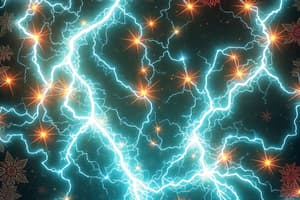Podcast
Questions and Answers
What is the purpose of rubbing two neutrally-charged objects together?
What is the purpose of rubbing two neutrally-charged objects together?
- To generate an electric field
- To change the physical properties of the objects
- To decrease the electron affinity of the objects
- To transfer electrons from one object to another (correct)
What determines the direction of electron transfer when rubbing two neutrally-charged objects together?
What determines the direction of electron transfer when rubbing two neutrally-charged objects together?
- The mass of the objects
- The volume of the objects
- The electron affinity of the objects (correct)
- The color of the objects
What is the purpose of the triboelectric series mentioned in the text?
What is the purpose of the triboelectric series mentioned in the text?
- To identify which materials have a higher chance to gain or lose electrons (correct)
- To determine which materials are magnetic
- To categorize materials based on their mass
- To rank materials based on their color
Which method of charging allows the transfer of electrons without physical contact between two uncharged objects?
Which method of charging allows the transfer of electrons without physical contact between two uncharged objects?
In charging by induction, how can two neutral metal spheres be charged with separate positive and negative charges?
In charging by induction, how can two neutral metal spheres be charged with separate positive and negative charges?
What term describes the chance for a neutrally charged object to gain electrons?
What term describes the chance for a neutrally charged object to gain electrons?
What happens when a negatively-charged object is brought into contact with a neutral metal sphere?
What happens when a negatively-charged object is brought into contact with a neutral metal sphere?
If a positively charged object is brought into contact with a neutral metal sphere, what happens?
If a positively charged object is brought into contact with a neutral metal sphere, what happens?
What is the process of transferring electrons from one object to another through rubbing known as?
What is the process of transferring electrons from one object to another through rubbing known as?
Why do protons not transfer between objects during the charging process?
Why do protons not transfer between objects during the charging process?
In charging by induction, what happens when a charged object is brought close to a neutral conductor?
In charging by induction, what happens when a charged object is brought close to a neutral conductor?
What is the result when a neutral metal sphere comes in contact with a positively charged object?
What is the result when a neutral metal sphere comes in contact with a positively charged object?
According to Coulomb's Law, what happens to the electrostatic force as the separation distance between charges increases?
According to Coulomb's Law, what happens to the electrostatic force as the separation distance between charges increases?
If two charges are brought closer together, what happens to the interaction between them according to Coulomb's Law?
If two charges are brought closer together, what happens to the interaction between them according to Coulomb's Law?
What is the relationship between the amount of charge on objects and the electrostatic force according to Coulomb's Law?
What is the relationship between the amount of charge on objects and the electrostatic force according to Coulomb's Law?
In a system where two charges experience an attractive force, what can be inferred about their nature?
In a system where two charges experience an attractive force, what can be inferred about their nature?
When two like charges experience a repulsive force, what conclusion can be drawn about their charges?
When two like charges experience a repulsive force, what conclusion can be drawn about their charges?
What does Charles-Augustin de Coulomb's mathematical equation describe?
What does Charles-Augustin de Coulomb's mathematical equation describe?
Flashcards are hidden until you start studying




